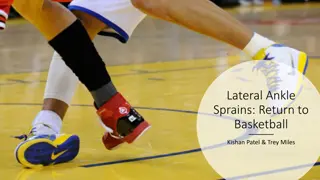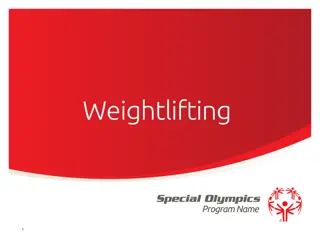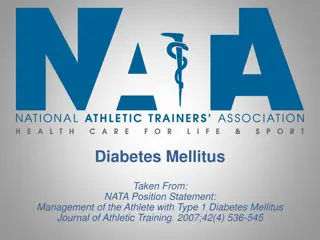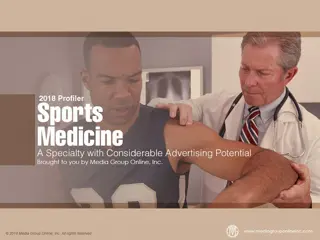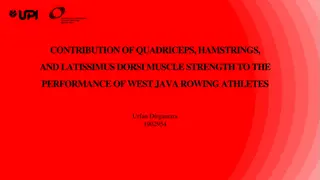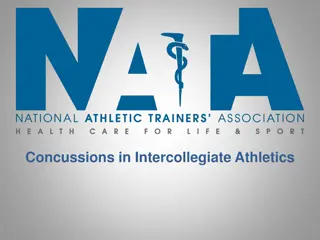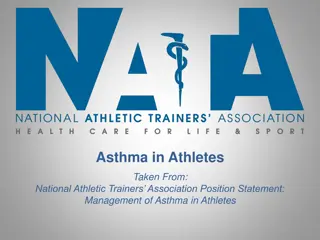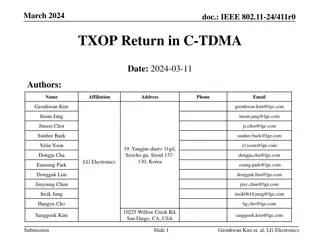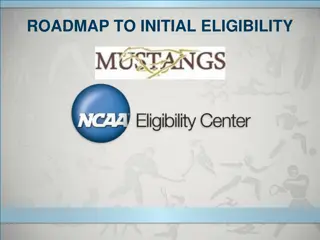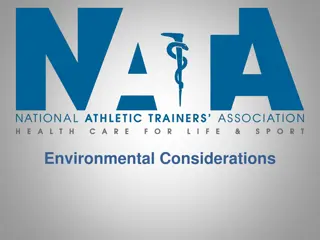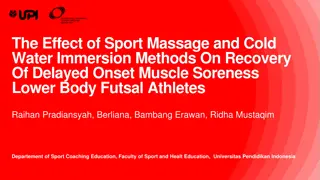Return to Play Guidelines and Criteria for Athletes
Discover the critical steps involved in the return to play process for injured athletes, including tissue response to injury, re-injury rates with and without certified athletic trainers, and key stages like immobilization, range of motion, basic strength, speed, and sport-specific function. Learn about the importance of each step and how decisions are made by athletic trainers and doctors to safely release athletes back to sports.
Download Presentation

Please find below an Image/Link to download the presentation.
The content on the website is provided AS IS for your information and personal use only. It may not be sold, licensed, or shared on other websites without obtaining consent from the author. Download presentation by click this link. If you encounter any issues during the download, it is possible that the publisher has removed the file from their server.
E N D
Presentation Transcript
Return to Play Guidelines & Critera Unit One: Tissue Response to Injury
Intro A study has indicated the re-injury rate for high school athletes who don t have a Certified Athletic Trainer is 70%. The re-injury rate for high school athletes who do have an Athletic Trainer is only 3%. Why do you think there is such a big difference?
Objectives 1. Define Return to Play Terminology. 2. Identify Return to Play Steps.
Return to Play The process an injured athlete goes through in order to safely resume sports competition.
How do you decide? If you were the athletic trainer or doctor, when would you release an athlete to return to play? What would it take? List the steps that the athlete would need to complete before returning to sports.
Return to Play 1. Immobilization 2. Range of Motion 3. Basic Strength 4. Balance, Speed, Power, and Agility 5. Sport-specific function 6. Partial Return to Play 7. Full Return to Play
Immobilization The period of time an athlete s injury is held still in a cast, brace, sling, or splint in order for adequate healing to occur.
Range of Motion The ability of the injured muscles & tissue to stretch far enough to allow the joint to complete its full ROM.
Basic Strength Muscles with an injury must be able to produce force equivalent to at least 95% their pre-injured state. Why would this matter?
Speed The ability of the athlete to cover ground quickly. What other exercises could an athlete do to help with speed for a shoulder injury?
Sport Specific Function The athlete s ability to demonstrate skills and movement required in their sport. Cutting, ladders drills, side shuffles, squatting
Partial Return to Play The injured athlete is released to participate in some, but not all practice activities. Restrictions might include contact drills, abrupt changes in direction, over-exertion, etc. Restrictions are dependent on the type and nature of the athlete s injury and the level of rehabilitation progress.
Full Return to play Release to all practices and competitions without limitations or restrictions
Recall the steps What are the 6 steps to return an athlete back to play? 1. Immobilization 2. Range of Motion 3. Basic Strength 4. Balance, Speed, Power, and Agility 5. Partial Return to Play 6. Full Return to Play
Criteria What does criteria mean to you? The specific level of the injured athlete must attain & demonstrate in order to progress to the next return to play step.
Immobilization to Range of Motion Criteria Sufficient healing time recommended by the physician or athletic trainer before the removal of brace, cast, sling or splint What would happen if we started ROM exercises too early?
Range of Motion to Basic Strength Criteria 90% of normal ROM must be restored before beginning strengthening exercises
Range of Motion The ability of the injured muscles & tissue to stretch far enough to allow the joint to complete its full range of motion.
Basic Strength to Agility, Balance, Power, & Speed Criteria Must have 90% of basic strength before beginning Agility, Speed and Power exercises
Agility, Balance, Power, & Speed to Sport-Specific Function Criteria 90% of Agility, power and speed before beginning Sport Specific Function
Sport-specific Function to Partial Return to Play Criteria Athlete needs to demonstrate ability to perform skills necessary to participate in his/her sport
Partial Return to Play to Full Return to Play Criteria Athlete is able to participate in limited practice without pain and no evidence of post-exercise swelling
Full Return to play Release to all practices and competitions without limitations or restrictions
Whats the criteria? The athlete has 90% pre-injury strength. What can he progress to? Strength speed Agility, power, balance &
Whats the Criteria? The athlete can now demonstrate full function with sport specific drills. Sport specific function Partial Return
Whats the criteria? The cast has been removed by the physician. Immobilization Range of Motion
Whats the Criteria? The athlete has shown no swelling, pain or problems in practice. Partial return to play Full Return
Exit Card On a small sheet of paper: List the steps to Return to Play IN ORDER.




